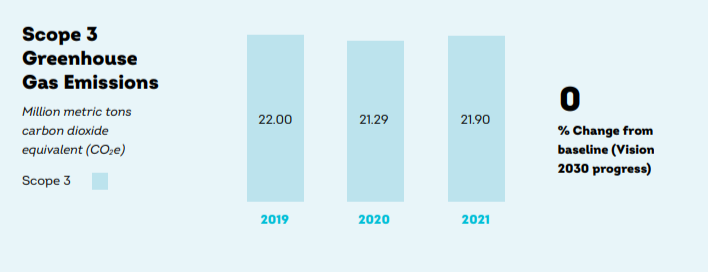International Paper on Improving Their Climate Impact
Originally published in International Paper's 2021 Sustainability Report
International Paper plays a significant role in responding to the global climate challenge, and our commitment to improve our climate impact is considerable in its potential.
We have a track record of reducing our Scope 1 and Scope 2 GHG emissions at our operations. Now, with our Vision 2030 goal, we are also engaging across our value chain to track, report on and, ultimately, reduce our Scope 3 emissions.
Addressing Scope 1 and 2 GHG Emissions
For more than a decade, we have reported the carbon impact of our operations and our initiatives to reduce our Scope 1 and 2 GHG emissions. We reduced our GHG emissions by approximately 20% between 2010 and 2020, while cutting our use of coal and fuel oil in half. We know we have much more work to do.
Today, approximately 70% of the energy we use in our mills is derived from carbon-neutral biomass residuals, with the remainder from purchased energy, including natural gas, electricity and steam from utilities, and smaller amounts of coal, fuel oil and other fuels.
We are committed to making the capital investments necessary to substantially reduce Scope 1 GHG emissions in our facilities over the next decade. We are evaluating and pursuing investments in energy efficiency and fuel-switching for lower-carbon power generation in our operations. Additionally, our manufacturing technology experts continue to identify operational efficiency opportunities at facilities across our business and regions. These initiatives often result in both cost savings and GHG emission reductions by optimizing processes, upgrading equipment and advancing energy conservation measures.
We also recognize the opportunities we have to reduce our Scope 2 GHG emissions through participation in renewable power development. We are exploring mechanisms such as virtual power purchase agreements, which support renewable energy suppliers and the “greening” of the electricity grid.
We currently do not use carbon offsets in our GHG emissions reduction strategy. We are engaging with a number of strategic partners to advance our understanding of GHG emissions accounting via natural climate solutions, including the Greenhouse Gas Protocol’s upcoming Land Sector and Removals Guidance and SBTi’s Forest, Land and Agriculture project, to help us advance this strategy in the coming years. We also continue to explore opportunities for forestland owners to employ practices that improve forest management for carbon sequestration.
As a partner in the US Department of Energy’s (DOE) Better Climate Challenge, International Paper is one of more than 80 organizations across the US economy collaborating to drive real-world action toward a low-carbon future. As we pursue our ambitious GHG targets, we will count on DOE and participating industrial companies for technical assistance, peer-to-peer learning opportunities and a platform to demonstrate our commitment to being part of the solution to climate change.
We track and report on our global GHG emissions through our participation in CDP, the U.S. Environmental Protection Agency’s Mandatory Reporting Rule, the European Union Emissions Trading System and various state, regional and national reporting programs.
Addressing Scope 3 GHG Emissions
Scope 3 GHG emissions include the GHG impacts generated within our upstream and downstream value chain, but outside of our direct operations. These include, for example, the carbon footprint of input materials like wood fiber and chemicals, GHG emissions related to our distribution networks, and from the further processing, reuse and final disposal of our products.
Measuring and reporting our Scope 3 GHG emissions is relatively new for International Paper. We are collaborating with our suppliers and customers to understand their GHG emissions footprint and decarbonization plans in order to develop strategic reduction pathways. In 2021, we developed a supply chain GHG emissions calculator tailored to our industry, in partnership with the National Council for Air and Stream Improvement (NCASI), to establish a detailed Scope 3 GHG emissions baseline and to track progress over time. In parallel, we began gathering supplier-specific GHG emissions and climate strategy data by participating in CDP’s Supply Chain program, which we intend to expand to more suppliers in coming years. Our Scope 3 work is closely linked to our goal for Renewable Solutions, which is focused on how we design and how our customers use and dispose of our products.
Setting Science-based Targets
Our GHG emissions reduction target was derived using a methodology approved by the Science Based Targets initiative (SBTi), a global collaboration of nongovernmental organizations and experts that has defined best practices and a scientifically informed methodology for emissions reductions. Our GHG emissions target is in line with the Paris Climate Agreement goal to limit global temperature rise to well below 2°C above pre-industrial levels.
Approximately 70% of mill energy derived from carbon-neutral biomass residuals
We have seen little net change in our combined Scope 1 and Scope 2 emissions from 2019 to 2021. This is largely due to increased mill production over this period, along with other factors driven by COVID-19 disruptions, mill operations, weather events and energy supplies. Our slight increase in Scope 1 emissions was largely offset by lower sales of Renewable Energy Certificates (RECs) at certain mills, resulting in lower Scope 2 emissions.
- Consistent with the GHG Protocol, our reported Scope 1 GHG emissions and associated targets do not include biogenic GHG emissions, which were approximately 24.7 million metric tons in 2021.
- Includes all fuel and energy sources at all manufacturing facilities.
- Residual Biomass is leftover material originally purchased as wood fiber, such as tree limbs and bark, and black liquor generated during the production process that is beneficially reused as a carbon-neutral energy source.
About International Paper
International Paper (NYSE: IP) is a leading global supplier of renewable fiber-based products. We produce corrugated packaging products that protect and promote goods, and enable worldwide commerce, and pulp for diapers, tissue and other personal care products that promote health and wellness. Headquartered in Memphis, Tenn., we employ approximately 38,000 colleagues globally. We serve customers worldwide, with manufacturing operations in North America, Latin America, North Africa and Europe. Net sales for 2021 were $19.4 billion. See how we’re building a better future for people, the planet, and our company at internationalpaper.com/Vision-2030.





